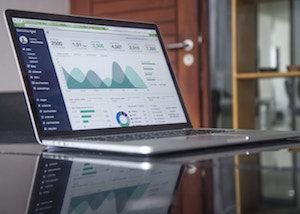
When you purchase a new vehicle, you get the fun of riding around in a new car with the new car smell! Our job has just begun – to get your new asset recorded properly on your books. We thought it’d be fun to give you a behind-the-scenes sneak peek at our part.
Sales Contract
The first thing we’ll ask you for is the sales contract. It will give us the payment price of your car, and we’ll use that number to record your new asset on your balance sheet. If you paid cash with no trade-in, the journal entry we’ll make is:
| Debit: 2019 Toyota RAV4 | $25,500 | |
| Credit: Cash | $25,500 |
Then we’ll decide on a depreciation method and book depreciation monthly or at year-end.
| Debit: Depreciation Expense | $5,100 | |
| Credit: Accumulated Depreciation: | $5,100 |
Trade-in
If you traded in a vehicle that is on your books, we’ll need to make an adjustment to your books. Effectively, your old car will be eliminated from your balance sheet. If this asset had a book value and it was not fully depreciated, the net value would be compared to the trade-in value and a gain or loss on the asset sale would be recorded on your income statement.
Let’s say the balance sheet value of the three-year-old car you traded in was $10,000 and you got $8,000 on the trade-in. Here’s what we would record:
| Debit: 2019 Toyota RAV4 | $25,500 | |
| Debit: Accumulated Depreciation | $15,000 | |
| Debit: Loss on Sale of 2016 Car | $2,000 | |
| Credit: Old 2016 Toyota RAV4 | $25,000 | |
| Credit: Cash | $17,500 ($25,500 – $8,000 trade-in) |
We’d also start the depreciation for the new car.
New Car Loan
Most often, a new car purchase will be financed, so we have a new liability to record too. We’ll need to get a copy of the loan documents from you and an amortization schedule of the payments. Let’s say you made a ten percent down payment with no trade-in. Here’s how that would look:
| Debit: 2019 Toyota RAV4 | $25,500 | |
| Credit: Cash | $2,550 | |
| Credit: Toyota Loan | $22,950 |
Then, each time you make a monthly payment, the amount will need to be split between principal and interest and those amounts will need to change each month.
| Debit: Interest Expense | $390 | |
| it: Toyota Loan | $60 | |
| Credit: Cash | $450 |
We left out a few trade secrets just to keep it intriguing. There are a lot of other numbers on a car purchase: taxes, licenses, warranties, add-ons, fees, and more. Some of these can be directly expensed, while others need to be included in the value of the asset. So if you’re happy that we’ll take care of this for you, we’re happy to do so.
Let us know if you purchase an asset this summer so we can get it booked right for you.

 While “fetching” might be what some trained dogs can do, accounting systems are getting into the act too. This relatively new feature is called “receipt fetching,” and it’s when an app can retrieve documents directly from the vendors that you do business with so you don’t have to spend so much time on paperwork retrieval.
While “fetching” might be what some trained dogs can do, accounting systems are getting into the act too. This relatively new feature is called “receipt fetching,” and it’s when an app can retrieve documents directly from the vendors that you do business with so you don’t have to spend so much time on paperwork retrieval. A quick glance is all you need to check your fuel gauge, speed limit, engine temperature, and RPM when you’re driving down the road. Your car’s dashboard is designed to focus you on what’s important and what you need to know to have a safe trip.
A quick glance is all you need to check your fuel gauge, speed limit, engine temperature, and RPM when you’re driving down the road. Your car’s dashboard is designed to focus you on what’s important and what you need to know to have a safe trip. The income statement of any business is probably the most important report of all. It is a snapshot of the financial performance of your business over a period of time, such as a month or year. You might also hear it called the Profit and Loss Statement, or P&L.
The income statement of any business is probably the most important report of all. It is a snapshot of the financial performance of your business over a period of time, such as a month or year. You might also hear it called the Profit and Loss Statement, or P&L. Year-end is just around the corner, and that means a couple of administrative tasks are necessary to take care of bookkeeping and tax chores. Here are a couple of tips to make year-end go smoother.
Year-end is just around the corner, and that means a couple of administrative tasks are necessary to take care of bookkeeping and tax chores. Here are a couple of tips to make year-end go smoother. Your “Chart of Accounts” is the list of accounts in your accounting software. The accounts are listed in your reports, and the totals allow you to determine how much you’ve spent, made, own, or owe depending on the type of account.
Your “Chart of Accounts” is the list of accounts in your accounting software. The accounts are listed in your reports, and the totals allow you to determine how much you’ve spent, made, own, or owe depending on the type of account. For small businesses formed as an S Corporation and with plenty of profits, reasonable compensation is a term you may want to be familiar with.
For small businesses formed as an S Corporation and with plenty of profits, reasonable compensation is a term you may want to be familiar with. If you’re struggling with your accounting system, it might be a sign that you’re ready for something new. Perhaps your company has grown so much that it’s outgrown its older accounting solution. Here are several indications to look for that justify moving to an accounting system with more features and scalability.
If you’re struggling with your accounting system, it might be a sign that you’re ready for something new. Perhaps your company has grown so much that it’s outgrown its older accounting solution. Here are several indications to look for that justify moving to an accounting system with more features and scalability.


.jpg)



